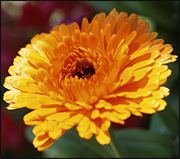Whether you accept it, avoid it or live somewhere in between, insurance coverage has become a defining issue for our profession. Patients increasingly expect to use their benefits, practitioners want to be compensated fairly for their time and expertise, and the system itself remains – at best – fragmented. The encouraging news is that coverage has expanded in meaningful ways. The challenging news is that reimbursement, across the board, remains inadequate.
Herbs & Botanicals
Chrysanthemum (ju hua)
What is chrysanthemum? What is it used for?
Chrysanthemum is a flowering plant that is native to China and Japan, but now grows worldwide. In China, it is found most often in the Zhejiang, Anhui, Henan and Sichuan provinces. Chrysanthemums come in a variety of colors, the most common being yellow and white. The cultivated, or domesticated, versions of chrysanthemums have large flower heads; wild varieties have smaller flower heads. Unlike most perennials, chrysanthemums bloom in the fall. They grow in well-drained soils that have plenty of sun. In addition to being an ornamental plant in many gardens, chrysanthemums are used medicinally in many cultures.
 The medicinal part of the chrysanthemum is the flower. The flowers are usually picked from the plants and allowed to dry - not in the sun, but in the shade - before use, and are used raw. The flowers contain a volatile oil made of a variety of amino acids and other substances, including borneol, camphor, adenine, and small amounts of vitamin B1.
The medicinal part of the chrysanthemum is the flower. The flowers are usually picked from the plants and allowed to dry - not in the sun, but in the shade - before use, and are used raw. The flowers contain a volatile oil made of a variety of amino acids and other substances, including borneol, camphor, adenine, and small amounts of vitamin B1.
In traditional Chinese medicine, chrysanthemum has pungent, sweet, bitter and slightly cold properties, and is associated with the Lung and Liver meridians. Its three main functions are to pacify the liver, to release toxins, and to dispel wind and clear heat.
Different colored chrysanthemums are used for different conditions. Yellow chrysanthemum is most commonly used to treat conditions associated with colds and flu, such as fever, headaches, chills and sore throat. White chrysanthemum's most common use is visual acuity; the flowers are often taken with other herbs to treat red, swollen eyes and blurred vision. White flowers are also sometimes used to treat dizziness.
How much chrysanthemum should I take?
The standard dose of chrysanthemum to be used depends on the condition being treated. Generally, most practitioners recommend 5 to 15 grams of dried chrysanthemum, usually in an infusion or decoction. Some practitioners recommend a type of chrysanthemum tea, which is made with crushed dried flowers and boiling water.
What forms of chrysanthemum are available?
Dried chrysanthemum flowers can be found at many Asian markets, and some herbal shops and flower shops. Some stores also sell powdered chrysanthemum flower.
What can happen if I take too much chrysanthemum? Are there any interactions I should be aware of? What precautions should I take?
As of this writing, there are no known drug interactions with chrysanthemum, nor are there any known side-effects from taking large quantities of chrysanthemum. However, people who are allergic to chrysanthemums or ragweed should not take the herb. As always, make sure to consult with a licensed health care provider before taking chrysanthemum or any other herbal remedy or dietary supplement.
References
- Huang KC. The Pharmacology of Chinese Herbs, 2nd ed. New York: CRC Press, 1999.
- Hussain Z, Waheed A,Qureshi RA, et al. The effect of medicinal plants of Islamabad and Murree region of Pakistan on insulin secretion from INS-1 cells. Phytother Res January 2004;18(1):73-7.
- Sharma SC, Tanwar RC, Kaur S. Contact dermatitis from chrysanthemums in India. Contact Dermatitis 1989;21:69-71.
- Ukiya M, et al. Constituents of compositae plants III. Anti-tumor promoting effects and cytotoxic activity against human cancer cell lines of triterpene diols and triols from edible chrysanthemum flowers. Cancer Lett 2002;177:7-12.
- Urzua A, Mendoza L. Antibacterial activity of fresh flower heads of chrysantemum coronarium. Fitoterapia September 2003;74(6):606-8.


